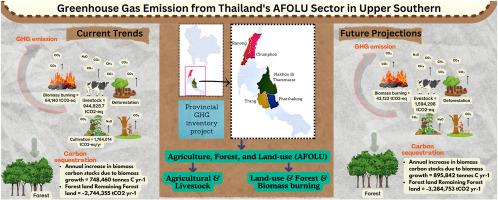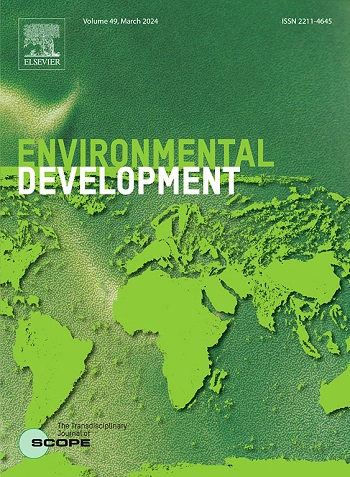泰国南部上部AFOLU部门的温室气体排放:当前趋势和未来预测
IF 5.3
2区 环境科学与生态学
Q2 ENVIRONMENTAL SCIENCES
引用次数: 0
摘要
本研究旨在调查泰国南部北部地区农业、林业和其他土地利用(AFOLU)部门的温室气体(GHG)排放情况,并在两种情景下预测到2030年的未来排放情况:照常经营(BAU)和国家目标(NT)情景。研究区域包括拉廊、春蓬、那空西塔玛拉、法塔隆和庄等5个省,它们拥有丰富的自然资源,包括红树林等碳汇生态系统。然而,这些省份持续的森林砍伐和农业扩张已成为温室气体排放的主要来源,特别是水稻种植和牲畜产生的甲烷(CH4)和森林转化产生的二氧化碳(CO2)。该研究采用了IPCC的指导方针来评估目前的排放量,并预测到2030年的未来排放量。结果表明,目前AFOLU的温室气体排放主要来自畜牧业(938,149吨CO2-eq)和水稻种植(261,745吨CO2-eq)。在BAU情景下,这些排放量预计将分别增加到159万吨二氧化碳当量和292,793吨二氧化碳当量。预计甲烷净排放量将上升,因为稻米排放量的减少被牲畜排放量的增加所抵消。与此同时,预计森林砍伐造成的二氧化碳排放量也将大幅增长。在北部地区情景下实施缓解措施,预计将使牲畜和水稻种植的排放量分别减少约5%和17%。此外,为了实现国家温室气体减排目标,区域和省份特定缓解战略的应用——如稻田交替干湿技术、改进粪肥管理和可持续土地利用实践——必须与当地情况和一致的国家政策相一致。本文章由计算机程序翻译,如有差异,请以英文原文为准。

Greenhouse gas emission from Thailand's AFOLU sector in upper southern: current trends and future projections
This study aims to investigate greenhouse gas (GHG) emissions from the Agriculture, Forestry, and Other Land Use (AFOLU) sector in Thailand's upper southern region, and to project future emissions through 2030 under two scenarios: Business-as-Usual (BAU) and the National Target (NT) scenario. The study area includes five provinces—Ranong, Chumphon, Nakhon Si Thammarat, Phatthalung, and Trang—characterized by abundant natural resources, including carbon-sequestering ecosystems such as mangrove forests. However, ongoing deforestation and agricultural expansion in these provinces have become major sources of GHG emissions, particularly methane (CH4) from rice cultivation and livestock, and carbon dioxide (CO2) from forest conversion.
The study employs IPCC guidelines to assess current emissions and project future emissions up to 2030. Results indicate that the current GHG emissions from AFOLU are primarily from livestock (938,149 tons CO2-eq) and rice cultivation (261,745 tons CO2-eq). Under the BAU scenario, these emissions are projected to increase to 1.59 million tons CO2-eq and 292,793 tons CO2-eq, respectively. Net methane emissions are expected to rise, as reductions in rice emissions are outweighed by increases from livestock. Meanwhile, CO2 emissions from deforestation are also projected to grow significantly.
Implementation of mitigation measures under the NT scenario is projected to reduce emissions from livestock and rice cultivation by approximately 5 % and 17 %, respectively. Furthermore, to achieve the national GHG emission reduction targets, the application of regional and provincial-specific mitigation strategies—such as alternate wetting and drying techniques in rice paddies, improved manure management, and sustainable land-use practices—must align with both the local context and consistent national policies.
求助全文
通过发布文献求助,成功后即可免费获取论文全文。
去求助
来源期刊

Environmental Development
Social Sciences-Geography, Planning and Development
CiteScore
8.40
自引率
1.90%
发文量
62
审稿时长
74 days
期刊介绍:
Environmental Development provides a future oriented, pro-active, authoritative source of information and learning for researchers, postgraduate students, policymakers, and managers, and bridges the gap between fundamental research and the application in management and policy practices. It stimulates the exchange and coupling of traditional scientific knowledge on the environment, with the experiential knowledge among decision makers and other stakeholders and also connects natural sciences and social and behavioral sciences. Environmental Development includes and promotes scientific work from the non-western world, and also strengthens the collaboration between the developed and developing world. Further it links environmental research to broader issues of economic and social-cultural developments, and is intended to shorten the delays between research and publication, while ensuring thorough peer review. Environmental Development also creates a forum for transnational communication, discussion and global action.
Environmental Development is open to a broad range of disciplines and authors. The journal welcomes, in particular, contributions from a younger generation of researchers, and papers expanding the frontiers of environmental sciences, pointing at new directions and innovative answers.
All submissions to Environmental Development are reviewed using the general criteria of quality, originality, precision, importance of topic and insights, clarity of exposition, which are in keeping with the journal''s aims and scope.
 求助内容:
求助内容: 应助结果提醒方式:
应助结果提醒方式:


